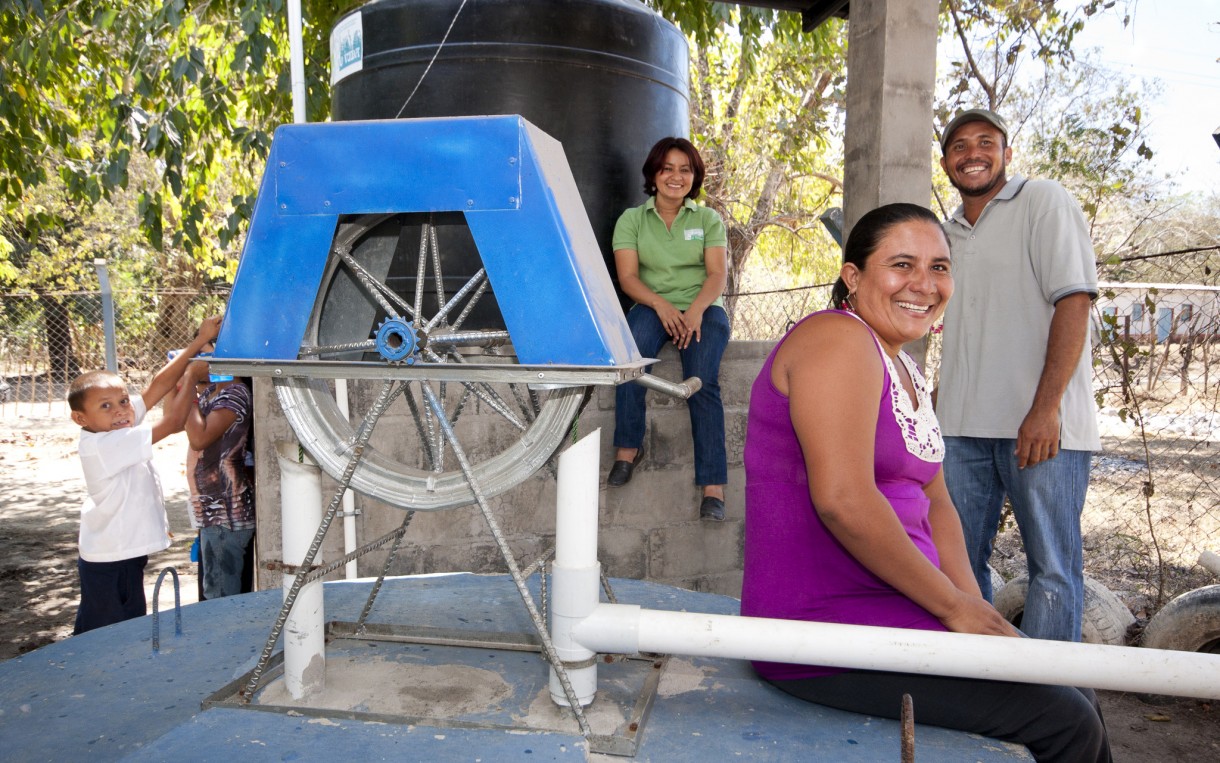Disaster preparedness requires leadership at all levels
 Estela Umaña sits near a healthy well in the village of El Salitral with health promoter and national WASH team member Felicita Escobar, and Remberto Aguilar, president of El Salitral's water committee. Healthy wells were installed by Oxfam partner PROVIDA to help ensure communities have access to a healthy water source, even in times of emergency.
Estela Umaña sits near a healthy well in the village of El Salitral with health promoter and national WASH team member Felicita Escobar, and Remberto Aguilar, president of El Salitral's water committee. Healthy wells were installed by Oxfam partner PROVIDA to help ensure communities have access to a healthy water source, even in times of emergency.
Ensuring countries and communities are prepared for disasters is everyone’s responsibility.
This blog post is the final post in a series about how people in El Salvador are working to prepare for, respond to and recover from emergencies. Previously: (1) While the sun shines: How Salvadorans are leading their own efforts to prepare for the worst; (2) How Salvadoran towns are leading on disaster management ; (3) Hurricanes don’t stop at the county line.
As a member of El Salvador’s legislature, Diputada Lourdes Palacios has been a key player in El Salvador’s effort to improve disaster preparedness for many years. She observed how the functioning of the legislature has changed over the last decade to be more responsive to citizen concerns. There is now more consultation with outside groups, local offices of the assembly, and legislative radio.
Salvadoran civil society groups advocated for many years for the legislature to take disaster preparedness serious, and adopt a national law on the subject. The legislature responded in 2005 passing a Civil Protection law. Yet many groups saw the new law as a disappointment; too narrowly focused on disaster response, not preparing for disasters before they hit.
Palacios described the struggles of herself and her legislative colleagues not only to pass an effective civil protection law, but also efforts to hold the executive accountable for effective implementation. She feels that reformers still lack the votes to further expand the scope of the law to match the original risk management intent. Instead, she says reformers have focused their energy on seeking a more effective risk management policy from the executive.
Responsibility for disaster response in El Salvador rests with the General Directorate for Civil Protection (DGPC), created by the 2005 law. Prior to the law, El Salvador had a “national emergency committee,” an ad hoc structure that was activated only once a disaster hit. If there was an emergency, committee would activate, emergency would end and everyone would go back to their jobs.
Since 2005, the DGPC has grown from an initial staff of 33 to 250. When Hurricane Ida hit in 2009, the storm revealed that the DGPC’s capacity need to be enhanced; with only 33 staff, the response was sub-optimal.
But one lesson from the emergency was the value of engaging sub-national government. Hurricane Ida’s impact was focused in just one regional department—San Vicente. At the time, El Salvador had only recently named governors for each of El Salvador’s fourteen regional departments. Based on the experience of Ida, DGPC started to work with governors and mayors to increase their knowledge and trust. They created advisory councils for different disciplines.
DGPC staff emphasize that all this work could not be done the government alone; their engagement with civil society has been key to strengthening the system. “One important element to us the role of the NGOs. When we came into government in 2009, we found that there were few people in national civil protection system. We saw that there were isolated efforts by NGOs. This system—because of its nature—is decentralized. It needs to flow out of communities though guidelines come from national level.”
Most importantly, they supported the mayors of El Salvador’s 262 municipalities to create community commissions. “We put together a structure, community commission, democratic groups that make decisions by majority vote. They need to be standing committees. We go and give them credentials, swear them in, so they feel ownership over it. We had to rebuild this so that citizens and officials understood their role within civil protection system.”
Members of the DGPC staff described how they support the commissions: “I have an address book with all the commission members. We send our staff out to train people and bring equipment to them. We have a basic kit we give them, documents to help them draft their community civil protection plans. We started with 56, now have 40 trainers. We have a train the trainers program. We think we need to continue training facilitators so they can continue to enhance our community commissions. We want to strengthen our national school for civil protection. It’s not a “building”, it’s a cohort of people who are trained and can train others. We are trying to establish online training for certain people.”
By 2014, there were 3117 active community commissions across El Salvador. None of this community level engagement was possible without increasing the staff and investment of the DGPC, and building out technical staff in all the departments. The Director has personally visited almost all of the municipalities. That allows people to know the Director personally—commission members see him as their boss.
—
Oxfam is advocating that humanitarian actors do more to support local leadership and self-reliance in preparing for, responding to, and recovering from emergencies:
- Read our flagship report about the need to reform the global humanitarian system;
- Read about our efforts to get the United States government to invest more in local self-reliance in emergencies;
- Read stories of the local heroes who are helping their countries and communities become disaster self-reliant.